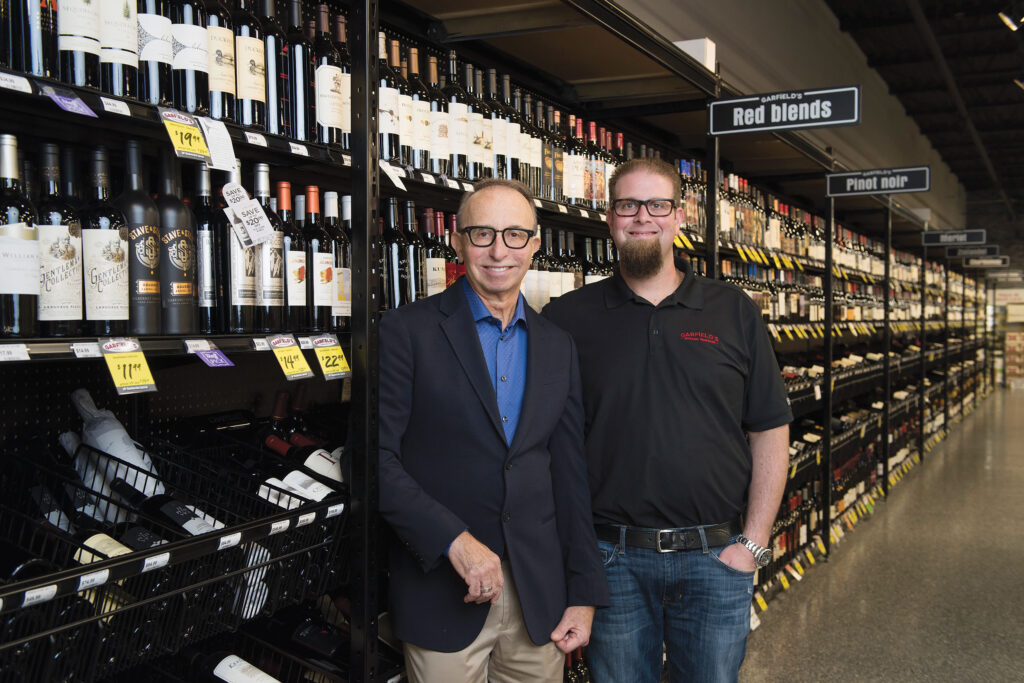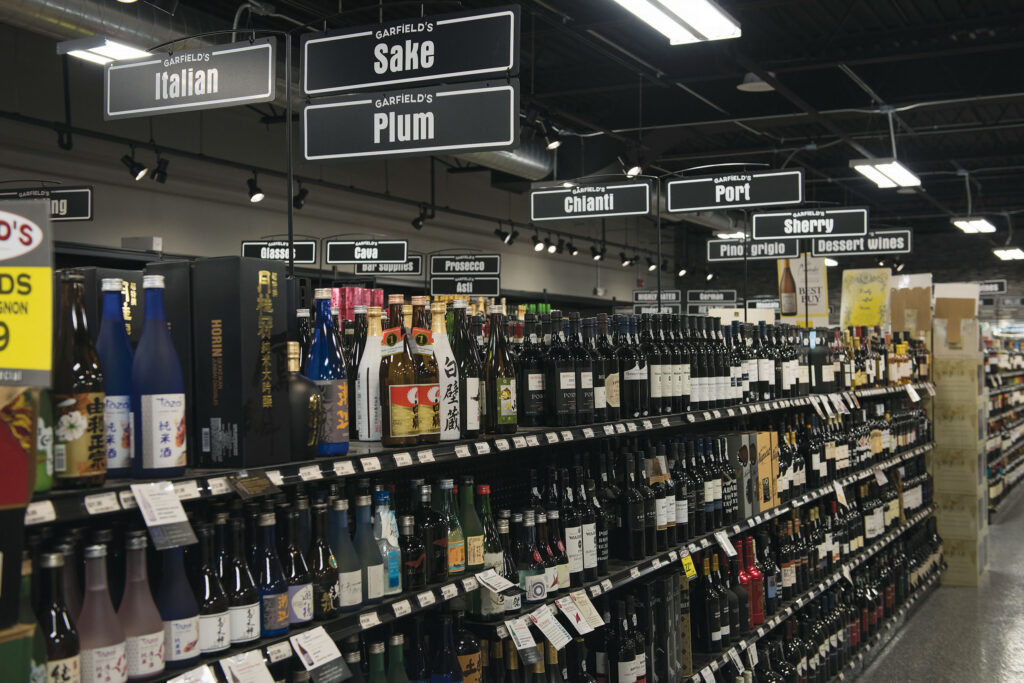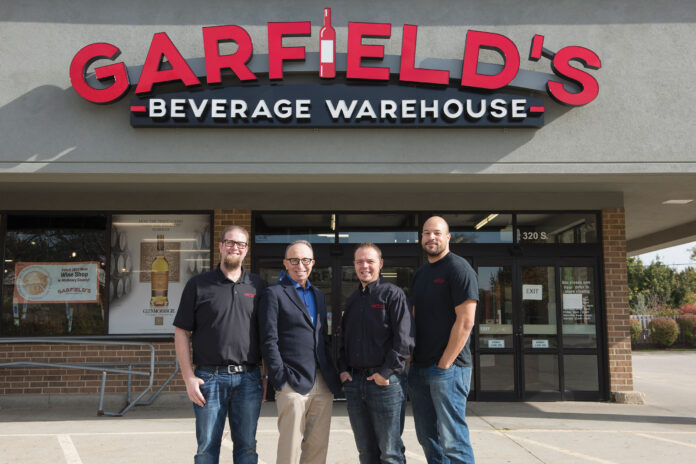Reaching the third generation at a family business is a difficult milestone to hit. Only 40% of successful businesses even see a second generation take leadership, while getting to the third sees the odds lowered even further to 13%.
Among that small number of exemplary family enterprises is Garfield’s Beverage Warehouse, in the Chicago metro region of Illinois. Owner Bruce Garfield — who took over from his father Norman, the company’s founder — has the privilege of working alongside his son David. Attaining this impressive third-generation status is yet another chapter in the story of Garfield’s, which dates back to 1951.
The Growth of Garfield’s
Norman Garfield was working for a liquor store called Three Corner Liquor in the early ‘50s, when he decided to open his own store. So he partnered with his cousin and they each came up with $1,000. Borrowing an additional $3,000 from uncles, they launched Cicero Cut-Rate Liquors in 1951, named for its home suburb in Chicago. (The term “cut-rate” was popular for liquor stores at the time, the modern equivalent the term “discount” now.)
Norman and his partner began their joint venture the same year that Bruce was born. Sadly, Norman’s partner passed away not long after, in his late 20s, following complications with diabetes. Bruce’s father was suddenly forced to run the shop by himself, working day and night, as Bruce recalls.
The effort paid off. In the mid-50s, Bruce moved the business into a bigger location down the block. It became a self-service model, which did very well, Bruce recalls. He has many memories of the store as a child, since he spent much time there growing up.
“As a kid, from six years old, I was working for my father every weekend,” he says, “washing floors and stocking work.”
In 1974, Bruce graduated college and returned to work for his father’s business full-time. A theme that defined the second and third generations soon emerged. “The intention was always for me to find another store to run,” Bruce says.
Two years later, he did just that. Cardinal Liquors launched in 1976 in Crystal Lake, IL, about an hour and a half north from Cicero. “It was a very good store,” Bruce says. “It was just 3,000 feet, a discount store.”
This was an era in the industry before grocery and convenience stores could sell alcohol in Illinois. New items were coming out in vodka and whiskey that attracted consumer attention, and the Garfield family business continued to perform well in the ‘70s.
“I was trying always to convince my father to keep expanding,” Bruce says. “He was a little more conservative than me.”
Still, expansion did come. Garfield’s purchased two more stores. They hired managers to run these locations, while Bruce and Norman remained in charge at their respective spots.
In the ‘80s, Norman had a health setback, so Bruce took over the leadership role atop all four stores. “I got used to running a chain,” Bruce says. “I always had the idea that we would add more stores to the chain.”
Bruce’s brother Bennett joined the family business in the early ‘80s, after finishing college. Bennett began helping their father at the Cicero location. Around this time, the idea came up to improve their buying power by forming a purchasing group with other independent operations.
“Two to three other stores joined our buying group at first,” Bruce says, “and then that kept expanding.”
At the same time, Bruce retained his desire to grow the business, and bought additional stores, owning five or six at a time. The buying group also flourished, expanding to 40 shops.
Success at that level required greater attention and responsibility. “My brother decided that he just wanted to concentrate on the buying group,” Bruce says, “while I liked being with the customers. So I took on the stores while my brother ran the buying group.”
A few years later, at the turn of the century, Bruce’s son David came into the business around age 20. After selling several smaller locations, the family-run stores were down to two big shops. David ran the Chicago site, while Bruce was head of the Crystal Lake spot.
“When I started at that store, I was at around $4.5 million annually,” David recalls. “I peaked at $9 million. I doubled volume there within the first few years.”
Growth was happening elsewhere.
“Around then, my brother was getting very aggressive in the buying group, putting stores everywhere and calling them ‘Cardinal’,” Bruce says. “We were also called ‘Cardinal’. So we decided to separate and called our stores ‘Garfield’s’, with our own identity, so that we could stand out.”
This big shift happened in 2015, and included new branding and signage for Bruce and David’s stores. It also saw the return to adding locations, as the father-son team saw eye-to-eye on expanding the chain.
“We felt that we could probably open up a new store every year,” Bruce says. “And that’s where we’re at today, with 11 stores now. They’re all called Garfield’s, and they range from 3,000 to 15,000 square feet. They’re in Chicago proper and also in the suburbs.”
Building out such a successful chain has been possible thanks to the family members atop the business.
“I love the fact that dad and I can work together,” David says. “I don’t think that he and I have ever been in a fight. We understand that we can’t agree on everything, but that’s not a big deal. On my end, it’s been great.”
His father has cherished the opportunity.
“When he was a young kid, I didn’t get to see him as much,” Bruce says of his son. “Now, to develop a relationship with him in business and in other levels, it’s very rewarding for me.”
“And I enjoy working with David and all the folks at our corporate office, because so many of them are a different generation than me,” Bruce adds. “They have different ideas than I do, and we fight it out every day and we really enjoy it.”

Garfield’s Today
It’s that corporate headquarters, located in Norridge, that represented the shift to a new, modern era for Garfield’s.
“When we had four to five stores, it was actually harder than today when we have 11 stores, because before we were all running between the stores, whereas today we have the infrastructure for multiple stores,” David says. “Now the setup is more corporate.”
Their strategy for opening new stores is dialed in. A good example is an addition that did not work. In 2008, Garfield’s launched a new location in Niles.
“We later sold Niles because there was a Binny’s nearby, a Liquor Barn nearby,” Bruce says. “The customers there only wanted to shop sales. It was hard to make money.”
Last fall, the company opened a new site in Naperville, a southwest suburb of Chicago.
“That store is in an upscale neighborhood,” David points out. “They’ve received us very well.”
“Location is key when opening a new store,” he adds. “You have to know what the customer traffic is in the area. What are you near? What is the level of income for the area? If it’s a new store opening in the city, then it has to be close to public transportation. Is there a parking lot nearby?”
Knowing the nearby competition is critical. Especially in a state like Illinois, where grocery and convenience stores can retail alcohol.
“There’s a liquor license on every corner in Chicago,” Bruce says. “We have to be aware of where we’re going in. Is there a 7-11 on the corner down the road?”
“We struggle to find locations where there’s not a Binny’s, a Costco or a Kroeger’s already right there,” David adds. “Both in the city and the suburbs. It’s a big factor, finding locations that are far from any larger competitor.”
Even if there are Big Box stores within the area, what helps set Garfield’s apart is the enhanced customer service.
“People come to us for the service and the recommendations,” Bruce explains. “We’re filling a niche. We want to find consumers who are excited about trying new items, who are excited about learning about new appellations..”
When scouting for locations with the right kinds of consumers around, the Garfield’s team takes note of what bars and restaurants are proximate. Lots of good cocktail bars in a neighborhood is an excellent sign of the desired, curious customer base.
On-premise service is also a large part of what makes Garfield’s work in retail. A number of the stores contain fully stocked bars.
“It’s something unique that we offer, another reason to come to our stores,” David says. “Instead of saying, ‘You need to try that’, we can say, ‘You can try it at the bar’.”
“It’s huge,” Bruce adds. “It drives the innovation of the store. It’s an avenue to expand the customer’s palate while also giving them the opportunity to try something that’s scarce. Especially with whiskey, it’s an opportunity to try some of these bottles at a price that’s not obscene.”
The bar is an excellent way to make effective, fair use of the small number of allocated bourbons distributed to the store. Stock them on the back bar and charge per pour, giving all customers equal chance at sampling rare whiskeys.
“It really takes the uncomfortable pressure off for allocated products,” David says.

What’s Trending, What’s Next
The beverage alcohol business currently faces a number of headwinds, fueled largely by changing consumer interests, especially among Gen Z. Still, trends always exist, driving growth.
“Tequila is still doing well,” David says, “although there’s been a shrink in dollar size. Luxury tequila was explosive during Covid, and now that has come down to earth. Customers are now exploring through the category.”
“We’re still seeing growth in RTDs, too,” he adds, “along with low-and-no products, and THC beverages.”
Cannabis drinks are having a moment nationwide, and it’s no different in Illinois. However, selling these products across a chain of stores in suburbs and the city can prove tricky.
“We’re figuring out in a few municipalities whether we can legally sell THC drinks there,” David explains, as some local laws broadly forbid cannabis sales. “Where we can sell it, we’ve expanded the sets. But we’re particular about what we bring in. We want to make sure it’s good for us.”
This sentiment currently echoes across the industry, as the flood of cannabis drinks in recent years means products may have rushed to market without proper testing and packaging. Questions remain about the actual psychotropic content and other ingredients in some of these SKUs. Smart retailers like Garfield’s have zeroed in on the most transparent THC brands.
“We self-regulate what we sell,” David says. “When we have conversations with municipalities about selling these products, we can point how the brands we sell have their full information listed out, right there on the can.”
Like the rest of the industry, Garfield’s has observed Gen Z and Millennials consumers drinking less and less. These younger generations — which are more health conscious and, especially Gen Z, will swap alcohol for cannabis — have affected how the industry operates.
“We’re not just about being there for your everyday drinker,” David says. “We want to be your go-to source for your vacation, for when you do decide to drink. We want to build that repertoire with consumer, and that’s why service is so important for us.”
“We have an ecommerce site for people who don’t want to come into the store,” he adds. “And we make sure our brand is at the forefront for customers who are just casually passing by.”
Of course, it’s not just younger consumers who are increasingly health conscious nowadays. The rapid rise of GLP-1 weight loss drugs has seen people of all ages cut back.
“GLP-1 drugs are not helping the case,” David says. “Alcohol consumption levels drop tremendously when you’re on those drugs. And you can’t fight that.”
Bruce also sees the healthier lifestyle as transcending generations, caused in part by recent historic events.
“After the pandemic, how much everyone drank during it, everyone thought, ‘I can’t keep doing that to my body,” he says. “And that has carried over until now.”
Nevertheless, despite ongoing industrywide headwinds, Garfield’s remains focused on growth and expansion.
“Even though business is not as good as we may want, we’re still looking to expand, both in the suburbs and in Chicago,” Bruce says. “We’re not as excited about opening new stores as when things are going great. We’re more cautious now than in the past. We’re optimistically cautious.”
Kyle Swartz is editor of Beverage Dynamics. Reach him at kswartz@epgacceleration.com. Read his recent pieces, 8 Beverage Alcohol Trends in 2025 and Our 2025 Spirits Growth Brands Awards Winners.



